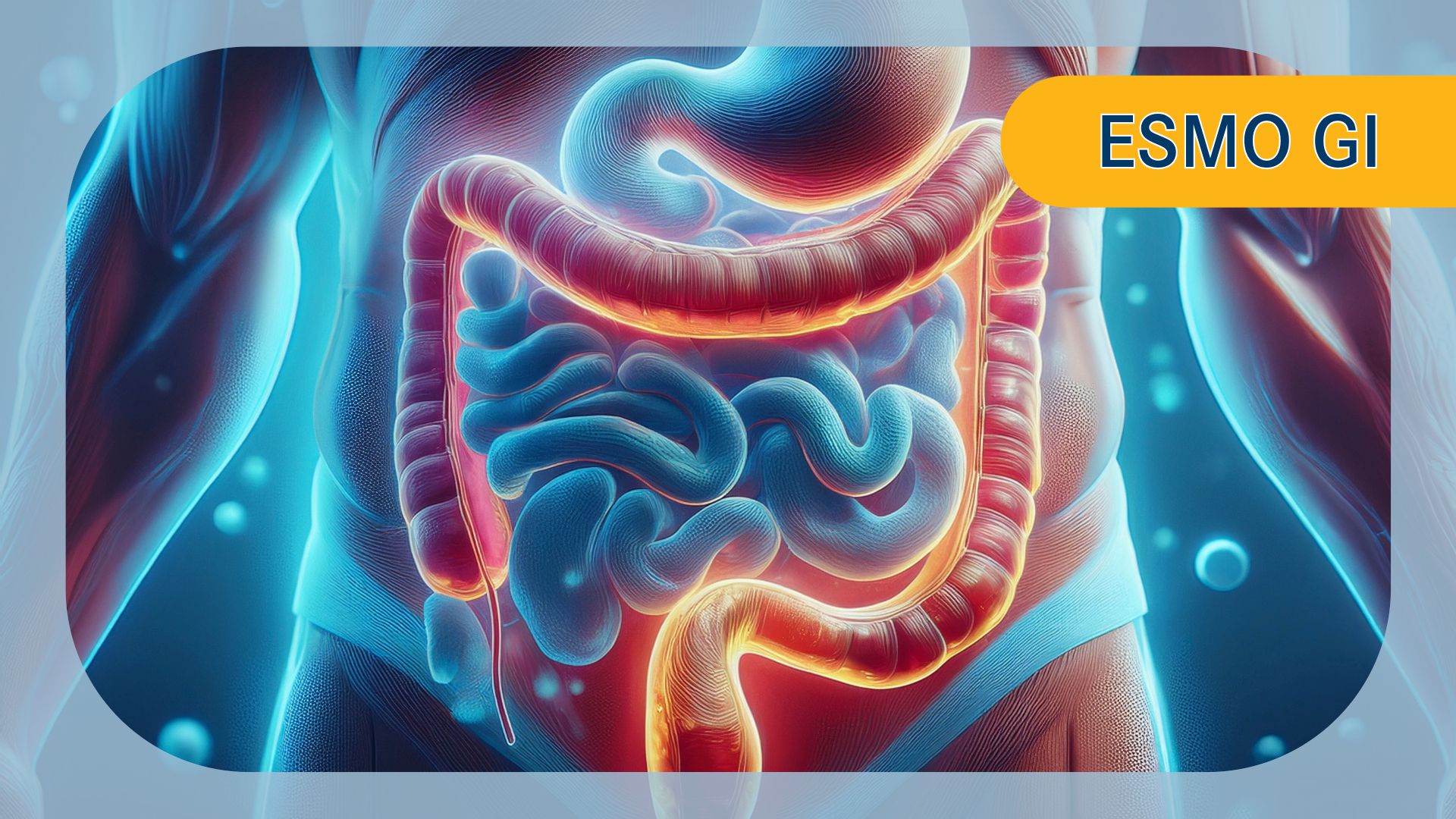Trifluridine/Tipiracil in ctDNA+ CRC |
Image Credit: © Ashling Wahner & MJH
Life Sciences Using AI
The use of trifluridine/tipiracil (Lonsurf) led to a numerical but not statistically significant improvement in disease-free survival (DFS) compared with placebo following curative resection in patients with colorectal cancer (CRC) who were positive for circulating tumor DNA (ctDNA), according to data from the phase 3 ALTAIR trial (NCT04457297).
Findings presented at the 2025 ESMO Gastrointestinal Cancers Congress revealed that in the overall population, patients treated with trifluridine/tipiracil (n = 122) achieved a median DFS of 9.30 months (7.92-10.84) compared with 5.55 months (95% CI, 4.17-7.33) in those given placebo (n = 121; HR, 0.79; 95% CI, 0.60-1.05; P = .107). In the trifluridine/tipiracil arm, the 12- and 24-month DFS rates were 31.8% (95% CI, 23.6%-40.2%) and 16.9% (95% CI, 10.4%-24.8%), respectively. These respective rates were 26.8% (95% CI, 19.16%-35%) and 14.5% (95% CI, 7.85%-23.1%) in the placebo arm.
“A [forest plot] analysis showed that patients with stage IV disease or microsatellite stable [MSS] status derived significant benefit from trifluridine/tipiracil,” lead study author Masahito Kotaka, MD, PhD, of Sano Hospital in Hyogo, Japan, said in a presentation of the data.
ALTAIR Overview
ALTAIR was part of the CIRCULATE Japan trial schema, and it included patients from the GALAXY (UMIN000039205) and VEGA trials who underwent curative resection for CRC and tested positive for ctDNA after surgery. Patients needed to be at least 20 years of age with no radiographic evidence of disease, and they received standard perioperative therapy. ctDNA monitoring was done using the Signatera assay.
Patients who tested positive for ctDNA were randomly assigned 1:1 to receive trifluridine/tipiracil or placebo for 6 cycles.
DFS served as the primary end point of ALTAIR. Secondary end points included ctDNA clearance rate, overall survival, safety, treatment completion rate, and quality of life (QOL).
Baseline characteristics were well balanced between the 2 arms. In the overall population of ALTAIR (n = 243), most patients were under 70 years of age (64%), male (58%), had left-sided tumors (71%), were ctDNA positive at 1 month following surgery (53%), had BRAF wild-type disease (96%), had RAS wild-type disease (61%), and had MSS disease (98%).
Disease stage at baseline comprised stage I (4.1%), stage II (24%), stage III (45%), and stage IV (27%). Thirty-six percent of patients received neoadjuvant therapy, and 46% underwent adjuvant treatment. Twenty-four percent of patients enrolled during the minimal residual disease window, defined as 2 to 10 weeks after surgery and prior to the start of adjuvant therapy; patients also enrolled while receiving adjuvant therapy (14%) and during surveillance (63%).
Additional DFS and ctDNA Data
In patients with stage IV disease, the median DFS was 9.76 months (95% CI, 7.62-11.76) in the trifluridine/tipiracil arm (n = 34) vs 3.96 months (95% CI, 3.71-7.98) for those in the placebo group (n = 32; HR, 0.53; 95% CI, 0.32-0.87; P = .012). In those with stage I to III disease, the median DFS was 9.27 months (95% CI, 7.62-10.97) and 6.05 months (95% CI, 4.63-9.23) for trifluridine/tipiracil (n = 88) and placebo (n = 89), respectively (HR, 0.86; 95% CI, 0.61-1.2; P = .375).
In the overall population, the rates of conversion to ctDNA negativity were 17.2% (95% CI, 11.0%-25.1%) in the trifluridine/tipiracil arm vs 12.4% (95% CI, 7.1%-19.6%) in the placebo group (odds ratio, 1.469; 95% CI, 0.718-3.008; P = .367). Conversion to ctDNA negativity was defined as a negative test at the first post-treatment assessment.
Safety and QOL Data
Any-grade adverse effects (AEs) occurred in 98.4% of patients in the trifluridine/tipiracil arm vs 57.0% of patients in the placebo group. The rates of grade 3 or higher AEs were 73.0% and 3.3%, respectively. Serious AEs and AEs leading to study discontinuation occurred in 4.9% and 6.6% of patients in the trifluridine/tipiracil arm, respectively. These rates were both 0% in the placebo arm. No patients in either group experienced AEs leading to death.
Any-grade AEs of note consisted of decreased neutrophil count (trifluridine/tipiracil, 74.6%; placebo, 4.1%), decreased white blood cell count (63.9%; 3.3%), decreased platelet count (12.3%; 3.3%), and decreased lymphocyte count (8.2%; 0.8%). In the trifluridine/tipiracil arm, the rates of these AEs occurring at grade 3 or higher were 56.6%, 17.2%, 1.6%, and 4.1%, respectively. None of these AE were reported at grade 3 or higher in the placebo arm.
AEs led to dose skipping in 95.1% of patients in the trifluridine/tipiracil arm vs 11.6% of patients in the placebo group. The rates of AEs leading to dose reductions were 37.7% and 0.8%, respectively. The median treatment duration was 174 days (range, 8-251) in the trifluridine/tipiracil arm vs 150 days (range, 40-187) in the control arm.
Regarding QOL, Kotaka noted that EORTC QLQ-C30 scores dropped during treatment, and a significant decrease in global health status occurred at week 8 in the trifluridine/tipiracil group (P = .028). No significant differences were reported between the arms following treatment from week 24 and beyond.
Disclosures: Kotaka reported receiving honoraria from Chugai Pharmaceuticals, Takeda Pharmaceuticals, and Eli Lilly.
Reference
Kotaka M, Bando H, Watanabe J, et al. Association of ctDNA clearance with disease-free survival, safety, and quality of life from ctDNA-directed therapy: Findings from the ALTAIR study. Presented at: 2025 ESMO Gastrointestinal Cancers Congress; July 2-5, 2025; Barcelona, Spain. Abstract 3O.
